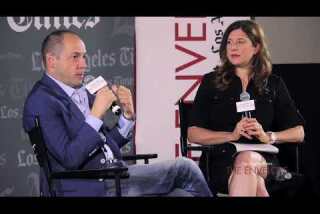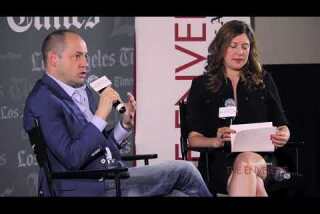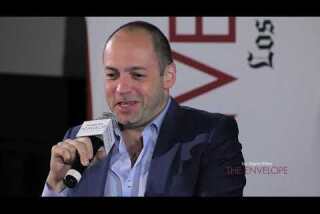Review: ‘Downton Abbey’ gears up for a grand old-fashioned finale as a new age dawns
- Share via
Cue the shot of Isis’ backside and John Lunn’s plaintive piano keys, hand round the linen handkerchiefs and get out the good china: Julian Fellowes’ “Masterpiece” masterpiece “Downton Abbey” returns on Sunday to remind us, for the sixth and final time, that the world has changed, is changing still, and everyone from Maggie Smith’s Dowager Countess to Sophie McShera’s former scullery maid had just better get used to it.
------------
For the record, 1:20 p.m. Jan. 1: An earlier version of this post referred to Maggie Smith’s character as the dowager duchess. She is the dowager countess.
------------
This time, for sure.
Or, you know, not. No show ever ends for certain these days. The characters of “Downton” could yet find new life in a sequel or spinoff or on the big screen, still bemoaning the death of the old ways even as Mrs. Patmore (Lesley Nicol) dusts the flour from her hands and Lady Mary (Michelle Dockery) allows her hair to be arranged.
SIGN UP for the free Classic Hollywood newsletter >>
Never before has such a large and disparate group teetered for so long on the precipice of social revolution. We first met the denizens of Downton — the Earl and Countess of Grantham (Hugh Bonneville and Elizabeth McGovern), their three daughters and sprawling staff — in 1912, when the death of the earl’s heir aboard the Titanic had thrown their orderly lives into turmoil. Who on earth would inherit Downton now? Not, heaven forbid, the young solicitor Matthew Crawley (Dan Stevens), who along with his forward-thinking mother (Penelope Wilton) eschewed the aristocracy and all it stood for.
Oh, yes, it would be he, yet another encroachment of the modern on the oppressively perfect class system that kept the Abbey’s Georgian magnificence running. Surely the sky would fall.
Which it did, in a manner of speaking. Originally planned as a miniseries, “Downton” ended with the outbreak of World War I, after which, one assumed, the dowager’s disdain for the working man’s “weekend” and the brutal intrusion of the telephone would be rendered moot by the real horror of the trenches and post-war industrialism.
But it was not to be. In a matter of weeks, “Downton” had become PBS’ first bona-fide hit in years and a key player in another revolution — one that would, ironically, demand that its characters hang on to at least the trappings of the old ways for as long as humanly possible.
Television, once considered as endangered as post-Edwardian manners, had reemerged as the first dominant art form of the 21st century. And while credit for the “new golden age” often goes to the explosion of rebranded networks and digital platforms, no show has embodied the great TV renaissance more perfectly than “Downton Abbey.”
Like one of its own absurdly convenient plot twists, “Downton” appeared from nowhere at the eleventh hour.
PBS, beset by funding cuts and an aging, dwindling audience, appeared on the brink of failure in 2011; just a month before “Downton” premiered, Los Angeles station KCET took the dramatic step of dropping its contract with the network. “Downton” had been a huge hit in the U.K., but historically that did not mean much — “Doctor Who” was still a cult show in the U.S. at the time, though that too was about to change. The Internet’s increasing fascination with television was making news about British (and French and Danish) shows far more accessible. “Downton” quickly enchanted the (much larger) American audience, which had been reintroduced to the pleasures of period drama through “Mad Men.”
Envelope Screening Series: ‘Downton Abbey’


Screening Series: 'Downton Abbey': An unexpected home

Screening Series: 'Downton Abbey': Kate Middleton on set

Screening Series: 'Downton Abbey': The cast

Screening Series: 'Downton Abbey': The future of the characters

Screening Series: 'Downton Abbey' | The show is born
Like “Mad Men,” “Downton” was a historical theme park of splendid interiors, exquisite domestic details and costumes to die for — with characters just modern enough to resonate.
Also like “Mad Men,” “Downton” revolved around a coterie of strong women: The three Crawley sisters, Lady Mary, Lady Edith (Laura Carmichael) and Lady Sybil (Jessica Brown Findlay) offered a diverse display of privileged but still encumbered femininity, while the downstairs population provided a rare glimpse into the teeming masses that make the splendor of any country in any age possible.
Most important, “Downton” had its dowager.
Though it has, indisputably, one of the finest casts in television, “Downton Abbey” might have remained a miniseries if not for Maggie Smith. Her Dowager Countess instantly gave the show spine, sparkle and spice. From the first season on, Fellowes wisely made her the show’s most quotable character.
Imagine. A PBS show with a quotable character.
PBS didn’t just have a hit, it had a viral hit, complete with star-studded spoofs, all manner of awards and an increasingly large cultural footprint. Unlike other traditional networks, PBS had merchandising platforms already in place. So long before “If Daryl Dies We Riot” mugs became hot, High Brit items traditionally confined to Signals catalogs began moving in a serious way, now augmented by the “Downton” brand. When PBS managed to pick up the American rights to “Sherlock,” it became as serious a player in the TV landscape as any repositioned cable network.
Fellowes, meanwhile, was faced with the enviable challenge of staving off the end he had so ominously predicted by keeping Downton and its inhabitants both comfortably familiar and dramatically besieged — by war, death, modern conveniences, changing values, in-house intrigue and an increasingly absurd murder plot line. Writing each script himself, he met the challenge by hoisting soap opera to high art; like a narrative chamber maid, Smith’s Violet came in at regular intervals to clear away the froth.
A brilliant combination of comic relief and sideline commentary, Violet, the original symbol of autocratic snobbery, soon became the show’s voice of reason.
Which says much about Fellowes’ attitude toward the aristocracy, not to mention the absurdity of Americans rooting for the preservation of the ultimate moneyed elite (the economic politics of “Downton” are beyond praying for at this point). From the beginning, Fellowes made his aristocrats American-tourist-friendly by endowing them with all manner of modern attitudes and tolerance. “Downstairs” quickly became simply a manner of speech — the kitchen staff was in the drawing room as often as they were in the kitchen — and so benevolent were the Crawleys as employers that it was difficult to see any servant’s desire for a “better life” as anything but ingratitude.
All of which continues, with whipped cream and cherries on top, in Season 6. Tension over the old ways and the new is relegated to a very subplot about the running of the local hospital and some ancillary nuisance involving other people’s tenants that offers McShera’s Daisy a chance to finally shine.
Everywhere else mutual support reigns as Bonneville’s Robert once again realizes that the day of the big country estate, with its army of footmen and chamber maids, is over. Also, that women are people: Mary has taken over running the estate, Edith has become a magazine editor and Cora (McGovern) is done playing second fiddle to the dowager.
Indeed, everyone is so amiable that the long-running feud between Mary and Edith, which comes to a rather dramatic head, seems increasingly odd and out of place.
Downstairs, the engagement of Mrs. Hughes (Phyllis Logan) and Mr. Carson (Jim Carter) is handled with tenderness, insight and good humor, while the plight of the Bad Luck Bateses (Joanne Froggatt and Brendan Coyle) may continue but is at least acknowledged in its extremity. (Coyle’s charming menace of a mobster in Esquire’s new “Spotless” does give Mr. Bates a new and troubling dimension.)
As usual, PBS made all but the last episode of the season available, but you’ll find no spoilers here. Suffice to say, Fellowes steams ahead as a quality purveyor of British confectionary. His ability to address real, and often quite traumatic, issues while maintaining a fairy-tale-like optimism is the show’s biggest appeal, along with his obvious love for his characters and their clothing. All signs point to an old-fashioned finale, with everyone, upstairs, downstairs and in my lady’s chamber, better equipped to meet the new age.
Which will be dawning Any Minute Now.
------------
‘Downton Abbey’ on ‘Masterpiece Classic’
Where: KOCE
When: 9 p.m. Sunday
Rating: TV-PG (may be unsuitable for young children)
ALSO
Buying into Showtime’s new Wall Street drama, ‘Billions’
‘The Shannara Chronicles’ marks MTV’s big leap into fantasy
Is there anything more to say about O.J. Simpson’s murder trial? Two projects say yes
The complete guide to home viewing
Get Screen Gab for everything about the TV shows and streaming movies everyone’s talking about.
You may occasionally receive promotional content from the Los Angeles Times.




